After doing some research, my suspicions that Sturzdorf was a fictional map created for Coh were confirmed. No such a town seems to exist in Germany. Nevertheless, the ingame description of Sturzdorf did give me some clues as to where I should look to find its historical background. The mention of the Tiger factory made me look towards Kassel, an important German industrial city during WWII, As Sturzdorf is most likely a wholly fictional map, you’ll excuse me for not finding any aerial pictures that would resemble it, except maybe for the one of the US army base in 1950. To compensate for this, I have images of the Kassel industrial site, bombing raids, heroic infantrymen, and just all out history hot sauce. Let’s go!
Picture: The Fieseler Aircraft Factory in Kassel after a Raid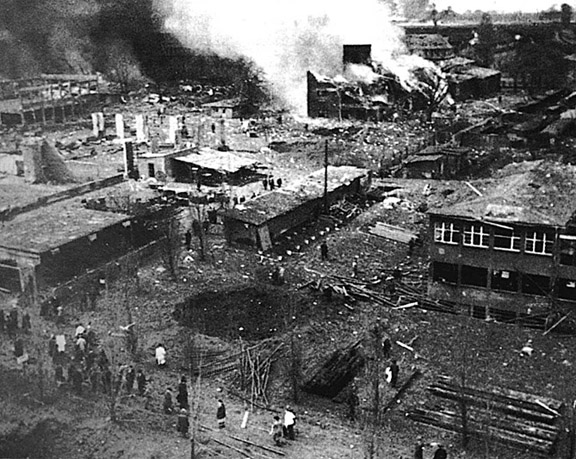
The city of Kassel in Germany was severely bombed during World War II and more than 10,000 civilians died during these raids. Kassel is located in the northern part of the state of Hessen, between Frankfurt (190 km south), and Hannover (160 km north). Kassel was home to the Henschel locomotive, engine and vehicle plants, the Fieseler aircraft plant, and several other important industries.
Picture: Tiger ‘Ace’ Michael Wittman speaks to the workers at the Kassel Tiger factory, 1944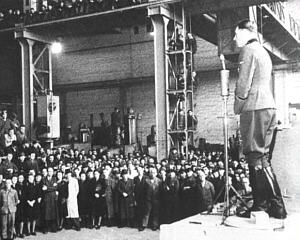
The Henschel plant started producing the turrets mounted with an 88mm gun for the Tiger tanks in 1942, and exponentially increased its production over the following years, right up until the end of the war. The city was also one of the most important transportation and communications centres for Central Germany.
Picture: mounting a turret on a Tiger Tank 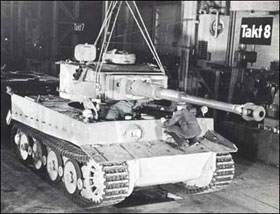
Logically, Kassel was considered an important strategic target for Arthur ‘Bomber’ Harris and the RAF Bomber Command. Both the RAF and the USAAF flew numerous raids on the city's industrial areas, but the old town centre was also completely devastated by carpet bombings.
Picture: Map for Allied Bombing Raid on Kassel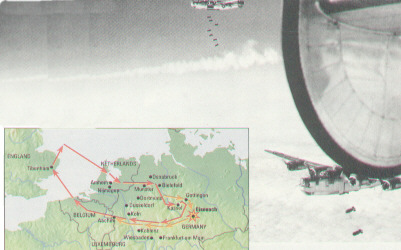
Despite the overwhelming allied air superiority, such air raids still proved to be very dangerous. One mission stands out: The 445th Bomb Group dispatched 37 bombers on a mission to Kassel on 27 September 1944. In the space of just a few minutes 30 B-24 Liberator bombers were downed in a surprise attack by the Luftwaffe. This was the highest loss an individual Bomber Group suffered during World War II . Only four of the Group's B-24's made it back to their base in Tibenham, 3 other planes managed to limp back to France where they had to perform a ‘belly’ landing.
Picture: destroyed synthetic oil plant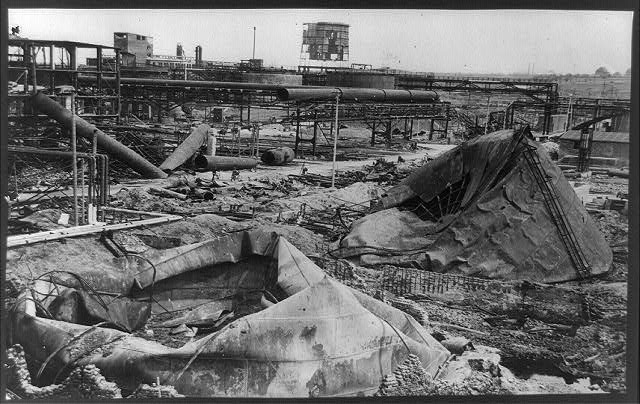
So even though the city of Kassel had endured the allied bombing campaign ever since 1942, the real fight for control of the city would only take place at the very end of the war: in April 1945. Despite the relative failure of operation Market Garden in the Netherlands, the Allied armies quickly bounced back and pursued their drive into Germany. The initial allied attacks into Germany actually constituted of four different but well coordinated operations.
Picture: Allied invasion of Germany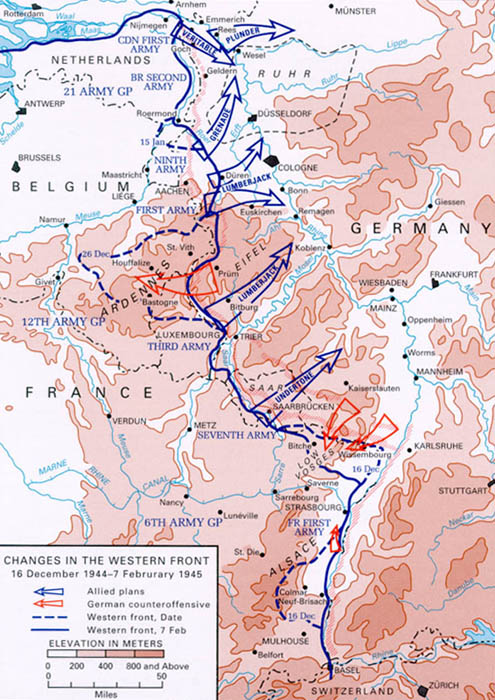
On this map, you find the details of the following Allied operations on the German border: Operation ‘Veritable’(South of Arnhem), Operation ‘Grenade’(with as objective Dusselforf and the Ruhr) , operation Lumberjack (towards the famous Remagen bridge, captured intact by the US 1st Army) and operation ‘Undertone’ (towards Mainz) . These battles raged from 8 February to 5 March 1945. After this, the way to the all important industrial Ruhr region lay wide open, but intense fighting would still be needed to clear the area riddled with pockets of fanatic German resistance. The cities of Kassel and Erfurt were declared such ‘fortress cites’ by their German defenders,
Picture: Tanks of the 702nd Tank Batallion, The Red Devils, in formation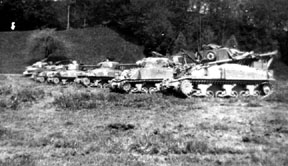
The American units involved in the fighting around Kassel were the 702nd Tank Batallion, the ‘Red Devils’, supported by the 80th Infantry Division.
According to the 702nd Tank Batallion Reports: ‘ Besides some Volkssturm units, enemy resistance was mainly comprised of elements and remnants of a few veteran divisions and innumerable miscellaneous units, slapped together in one last defensive effort before capitulation. Key terrain features were defended with suicidal resistance to the last. It is noteworthy that German artillery was almost non-existent. Several moderately heavy concentrations were received during the attack of Kassel but elsewhere only light and scattered artillery was received. Considerable tank activity was experienced during the first half of the month. Enemy air activity was a daily occurrence. Major use was made of demolitions, road cratering, blown bridges, defended road blocks and mines in a effort to prolong the coming of the inevitable hangman's noose.’
Picture: Kassel’s old town Centre in 1945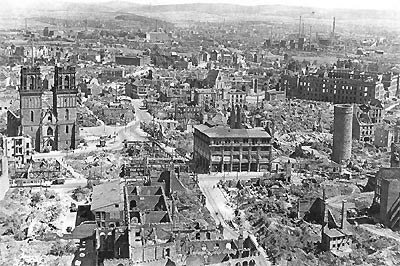
Platoon Leader of the 702nd, Lt. “Slim” Rives testimony goes as follows. ‘My best recollection of Kassel was that my platoon captured a wine cellar. We loaded our tanks with all we could carry. Later we heard that higher headquarters took it over, and inventoried forty-thousand bottles of high quality French wine. We also feared the attack on Kassel because it was either the factory for the Tiger Tanks or was a big mobilizing depot for the Tigers. As the Germans were out of fuel they could not mobilize the tanks, so the attack on Kassel was pretty much a "fizzle". ”
Picture: Tiger and Panther assembly line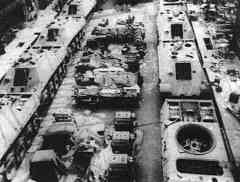
The 702nd Tank Battalion Intelligence Officer, Carl Nordstrom also remembered the Tiger Tank factory near Kassel. The air corps had tried many times to level the factory, in order to halt German tank production. The entire area surrounding the factory had been levelled in the carpet bombing, but the factory remained virtually unscathed and continued production right up to it’s capture by the Americans. Nordstrom thought it remarkable that in spite of the destruction surrounding it, this one factory still stood.
Picture: Kassel Ordnance Rebuild Shop, US Army base in 1950. Looks like sturz, no?
Let’s get to the actual fighting around Kassel now. April 1st found the 80th Division south of Kassel on the Third U.S. Army and XX corps left flank. Opposing their forces were elements of the 166th and 356th Infantry Divisions, plus many miscellaneous units including replacement, anti-aircraft and Volkssturm battalions. Fierce resistance from enemy small arms, automatic weapons, mortar and direct fire weapons met the attacking Allied forces north of the Eder River.
The Infantry assaulted the city from the south and west. Bitter resistance was met at the outskirts of the city, from dug-in infantry supported by high velocity direct-fire weapons and heavy tanks. The tanks which were used in the defence of Kassel, were the first that the 702nd Tank Batallion had met in any number since leaving the area of Losheim a few weeks earlier. The unit involved was the Panzer N.C.O. School, Eisenach, and originally had thirty-two tanks, divided into four companies of eight tanks each. Companies 1, 2, and 3 had Mk. IV tanks while 4 was equipped with Mk. V's. At first Tigers were reported in the vicinity, but they were found to be dead tanks having been destroyed by their own crews.
Picture: King Tiger Turrets waiting for assembly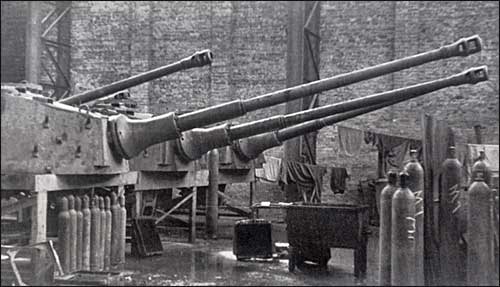
Early in the morning of April 2nd, the Battalion’s forward elements received a strong counterattack by twelve MkIV and MkV tanks, and an unknown number of troops from south of Kassel. Six allied tanks were knocked out during the engagement. Fierce resistance from small arms, machine guns and direct fire was encountered during the morning, as they advanced on Kassel. During the afternoon, resistance slackened somewhat, as the Allied forces entered Kassel and cleared two thirds of the town. By midnight scattered pockets of resistance were being mopped up in Kassel during the night.
Picture: Bob Costley’s Hand Drawn Map of operations around Kassel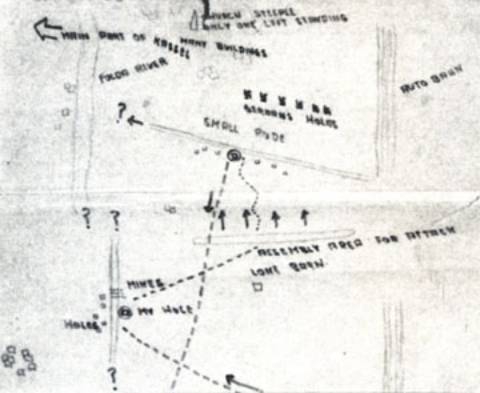
One heroic soldier’s story aptly characterizes these bitter skirmishes around Kassel: On the evening of April 3rd, 1945 John Dolan of the 80th Infantry stopped two Tiger tanks alone with a bazooka. Fellow veteran Bob Costley said: ‘For the sceptic wondering how a single G.I. could stop these Tiger tanks with a bazooka, it did happen. Knocking the track off of the lead tank, the second bazooka firing--how effective, I don't know. The road was narrowed by a bridge, possibly they couldn't move around and also they could of lacked the will to fight and abandoned them.’
Picture: Bob Costley exiting Kassel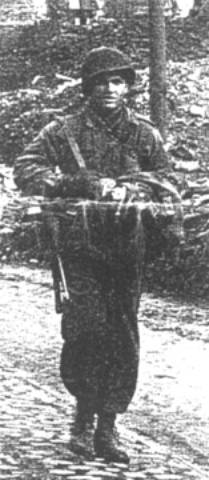
Early in the morning, at 12:30am, General Major Erxleben, Commanding General of the garrison at Kassel, surrendered himself and an estimated four hundred men to American forces. This ended the battle for Kassel, and the city was cleared.
However, the Americans infantry divisions that took Kassel were in for another nasty surprise. On the 8th of April, 1945 the 80th infantry division renewed it's advance to the southeast. On April 11th, the Regiment's 1st Battalion, while being trucked on the autobahn near the town of Possendorff, was ambushed by the Germans. This ambush subjected the entire convoy's serial to intense machine gun fire from well-prepared positions in a line of woods, paralleling the left roadway. The fighting was intense but lasted less than 40 minutes. It was thought that the SS men that were encountered there were from Buchenwald, as many of the SS guards had left the camp to engage the approaching Third Army. Rudy Tomasik of Woodstock, Connecticut, was awarded the Silver Star for his action here. The commendation was given for standing up straight under intense fire while firing his jeep-mounted 50-caliber machine gun into the woods, allowing the GI's time to reorganize.
Picture: Rudy Tomasik’s Jeep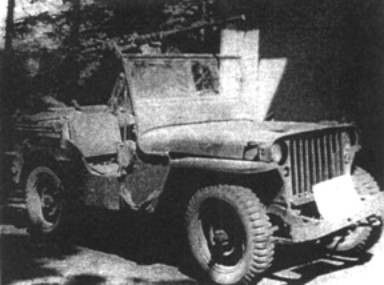
Durning these events , the Soviet Armies were mercilessly pushing forward to Berlin, and they reached its outskirts by the end of April. After the fierce battle for Berlin, which left many thousands dead and the city in ruins, WW2 in Europe was finally over and the Cold War could begin……
Bonus pic: A Calliope getting ready to fire in the Kassel region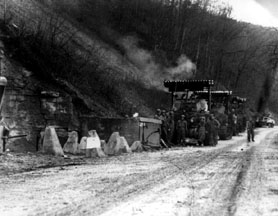
There you have it my friends: even though I am unable to confirm with absolute certainty that Kassel was indeed the inspiration for Sturzdorf, I hope that the above mentioned information will suffice for you guys to concur with my observations.















